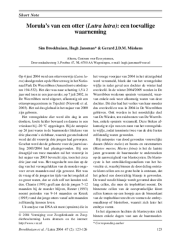Lutra 47(2)_Broekhuizen et al_2004

The accidental discovery of a morula in an otter (Lutra lutra) (Nederlandstalig: Morula’s van een otter (Lutra lutra): een toevallige waarneming)
On the 24th of June, 2004, a four year old female otter (Lutra lutra) was killed by a car in the reintroduction area National Park De Weerribben (province of Overijssel, The Netherlands). She originated from a rehabilitation centre in the Czech Republic and was reintroduced in De Weerribben early July 2002. During postmortem examination three placenta scars were noticed. In January 2004 a spraint of a newborn otter was found that genetically matched to this female and a male otter that originated from Belarus. In the winter of 2004/2005 again spraints of this cub were found as well as spraints of a second cub that was missed the winter before. The cubs were probably born in the autumn of 2003, meaning they were approximately seven months old when the mother died. We assume these cubs were on the brink of independency. Most mustelid species we receive for postmortem examination are pine marten (Martes martes), stone marten (Martes foina), and badger (Meles meles). Those mustelids have a delayed implantation of the blastocysts in the uterus. For measuring the reproductive status we routinely inject water through the uterus horns and collect the follow-through. This we check under a binocular for blastocysts. During post-mortem examination of this female otter we didn’t deviate from our protocol, although we knew it would be very exceptional to find a fertilized egg not yet attached in the uterus, since otters don’t have a delayed implantation. To our great surprise we did find three morula’s with a well developed zona pellucida, but no signs of formation of the cavity (blastula). We do not know what the duration is of the journey of a fertilized egg through the oviduct before nestling in the uterus. In ferrets (Mustela furo) it takes five days and in humans approximately three days. We think that the chance of finding this early stage of pregnancy is extremely small in European otters. Therefore we were very lucky, apart form the death of this reproductive otter female.
